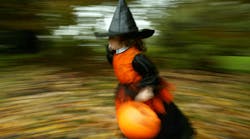Tips to Avoid the Scariest Place Of All – the Emergency Department – on Halloween
Each year, 9.2 million babies, children and teens are injured severely enough to need treatment in emergency departments all across America, reports the Centers for Disease Control and Prevention.
“Nothing is scarier than a trip to the emergency room,” said Mark Cichon, DO, chair, Department of Emergency Medicine, Loyola University Health System. “In a season devoted to frights, it is our goal to keep everyone safe.”
Here are Dr. Cichon's top tips to avoid going bump in the night and for a healthy, happy Halloween:
Invest in a pumpkin carving kit and avoid knives. “Manipulating a sharp knife in a rigid pumpkin rind without injury is almost impossible for an adult or child,” said Cichon, a professor at Stritch School of Medicine, Loyola University. “Proper tools make sure you carve the jack o’ lantern and not yourself or a loved one.”
Supervise anything that is burning, from scented candles to carved pumpkins to firepits. “Fires can happen in a flash and get quickly out of control,” said Cichon. “The colder temperatures invite the warm glow of candles to the excitement of an end-of-season bonfire. Watch out for burning leaf piles.”
Use extra precaution when climbing ladders to hang decorations inside and outside. “Falls from ladders are one of the top reasons adults come to the emergency room and they are largely avoidable,” said Cichon. “Use the right-sized ladder, and one that is safe, and work with a partner to do the job right.”
Make sure Halloween costumes offer visibility and ease of movement. “Masks, hats, wigs, glasses, hoods – costumes often include headgear that can obstruct vision and lead to trips and falls,” Cichon cautioned. “And make sure it is easy to walk in the costume without tripping or catching on things.”
Dress for the weather. “It is easy to get overheated or too cold at this time of year, without the addition of wearing a costume,” Cichon pointed out. “Check skin temperature and watch for signs such as shivering or lethargy. Don’t forget to wear waterproof footgear that has treads for sure footing.”
Make sure your group is visible to motorists. Have one adult in the trick-or-treating group wear a reflective safety vest and give each child a glow stick or flashlight to increase visibility. “You want to be able to see where you are going and also for others to see you, especially around moving vehicles,” said Cichon. Stay in a group and put kids on the buddy system.
Avoid alcohol use when supervising children. “Don’t drink and accompany your kids as they trick-or-treat,” said Cichon. “If you choose, enjoy a beer or cocktail at the end of the night after kids are safely indoors, or better yet, in bed.”
Avoid over-tiring children. “Fatigue can lower resistance, leading to illness and injury,” warned Cichon. Make sure a good night’s sleep starts Halloween day and rest up before the night's activities. Eat healthy meals and drink plenty of water to stay hydrated. Maintain regular bedtimes.
Inspect treats when you get home. “Make sure candy and goodies are age-appropriate; avoid smaller pieces for younger children that could be a choking hazard,” said Cichon. And, if your child has food allergies such as a peanut allergy, remember to remove that candy from the bag.
Balance candy consumption with healthy foods. “When my four children were younger, my wife and I would hide their candy and allow them each to choose two pieces after dinner to limit over-consumption,” remembered Cichon.
Be aware of the potential for loud and scary noises. “Playful scaring antics by enthusiastic celebrants and even barking dogs can frighten children and cause them to react suddenly,” Cichon warned. “Falling down porch stairs, tripping over curbs and even colliding with others can result in harm.”
Drive vehicles slowly and cautiously on Halloween, especially on sidestreets. “Watch for trick-or-treaters but also be aware of any flying eggs or other debris that could impede vision,” Cichon cautioned.

